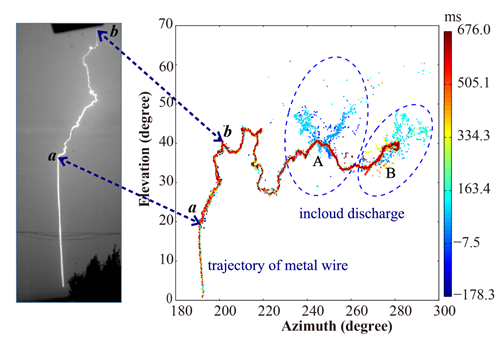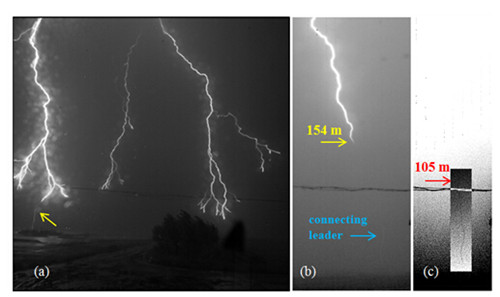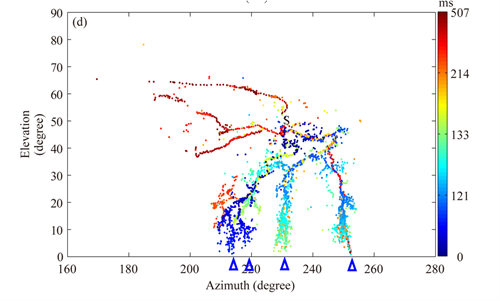Scientists Track Lightning Propagation and Strike at Ground Using High-resolution Detection Technology
Date:2016-01-25
As a transient discharge event with large peak current and high voltage in nature, lightning is concerned widely for its development characteristics and mechanism. Cloud-to-ground (CG) lightning initiates with preliminary breakdown inside thunderstorm, propagates toward the ground and finally strikes ground objects. The incloud breakdown processes and instant attachment processes with ground objectives are frontiers of lightning physics research, and the junction heights and lightning discharge parameters are also key parameters for lightning protection design. Nevertheless, these processes and parameters are very difficult to be detected accurately due to the instantaneous and stochastic nature of lightning discharges.
Recently, Prof. QIE Xiushu and her colleagues from Institute of Atmospheric Physics developed a short-baseline lightning VHF radiation location system with high time resolution and high location precision, and achieved some new research findings in lightning physics by employing the new technology. The system dynamically maps the progression of lightning discharge with time resolution of 1 microsecond or even higher and the two-dimensional location accuracy is within 1 m at a distance about 1 km.
"Based on simultaneous observations of the lightning VHF radiation location system and high-speed camera during the Shandong Artificially Triggering Lightning Experiment, we documented data for both of rocket-triggered lightning and natural lightning flashes, and revealed propagation characteristics of lightning discharge channels and the instant attachment process with ground for negative CG flashes.” Prof. QIE explained her team work, “Usually, CG flashes strike the ground with one termination, while some of them present multiple-ground terminations.”

Fig. 1 Comparison of a rocket-triggered lightning ?ash mapped by the independent short-baseline lightning VHF radiation location system (right) and one frame from high-speed video images (left) (Figure plotted by IAP)

Fig. 2 Images of attachment processes for first and subsequent return strokes in natural lightning (Figure c is a regional contrast-modified image of Figure b, with the color-reversed connecting leader of subsequent return stroke) (Figure plotted by IAP)

Fig. 3 Progression of a lightning flash with multiple-ground terminations mapped by the lightning VHF radiation location system with time resolution of 1 microsecond. (Figure plotted by IAP)
Her team members Dr. JIANG Jiang and Dr. SUN Zhuling revealed two mechanisms for multiple-ground terminations: different incloud preliminary breakdown branches propagate outside the cloud and contact ground with different channels, or different stepped-leader branches sharing same incloud and upper main channel contact ground in sequence(Jiang et al, 2015; Sun et al , 2016). It’s found that the junction height of the first stepped leader-return stroke are about 50 m, while the dart leader with speed of higher than 107 m/s generates chaotic electric pulse trains, exhibits high junction height up to hundreds of meters, and results in intense return stroke, which is quite different from the normal dart leader with short junction height in the order of meters (Jiang al, 2015).
Bidirectional propagation of a dart leader with simultaneous positive and negative leaders in opposite directions was also observed for the first time in natural lightning by the team. The team also found a new charge transferring mode from cloud to ground, exhibiting both stroke and M component behavior. These series findings have been recently published on Journal of Geophysical Research – Atmosphere and Geophysical Research Letters.
Reference:
Sun, Z., X. Qie, M. Liu, R. Jiang, Z. Wang, and H. Zhang (2016), Characteristics of a negative lightning with multiple-ground terminations observed by a VHF lightning location system, J. Geophys. Res. Atmos., 121, doi: 10.1002/2015JD023702. http://onlinelibrary.wiley.com/doi/10.1002/2015JD023702/full
Jiang R., X. Qie, Z. Wang, H. Zhang, G. Lu, Z. Sun, M. Liu, X. Li (2015), Characteristics of lightning leader propagation and ground attachment. J. Geophys. Res., 120, 11,988-12,002, doi:10.1002/2015JD023519. http://onlinelibrary.wiley.com/doi/10.1002/2015JD023519/full
Jiang, R., Z. Wu, X. Qie, D. Wang, and M. Liu (2014), High-speed video evidence of a dart leader with bidirectional development. Geophys. Res. Lett., 41, doi: 10.1002/2014GL060585. http://onlinelibrary.wiley.com/doi/10.1002/2014GL060585/full
Sun, Z., X. Qie, R. Jiang, M. Liu, X. Wu, Z. Wang, G. Lu, and H. Zhang (2014), Characteristics of a rocket-triggered lightning flash with large stroke number and the associated leader propagation. J. Geophys. Res., 119, 13,388-13,399. http://onlinelibrary.wiley.com/doi/10.1002/2014JD022100/full
Qie, X., R. Jiang, C. Wang, J. Yang, J. Wang, and D. Liu (2011), Simultaneously measured current, luminosity, and electric field pulses in a rocket-triggered lightning flash, J. Geophys. Res., 116, D10102, doi:10.1029/2010JD015331 http://onlinelibrary.wiley.com/doi/10.1029/2010JD015331/full
Contact: QIE Xiushu, qiex@mail.iap.ac.cn
